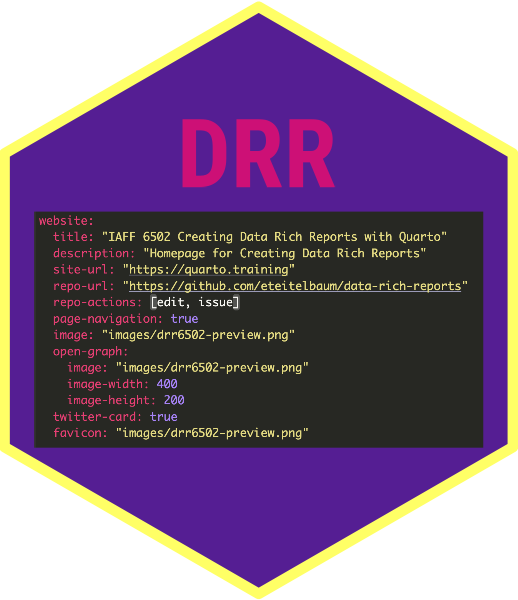10:00
Data Rich Reports
Session 6–Websites and Blogs
Quarto for Websites and Blogs
- Generate static websites, blogs but also allows for embedding of interactive applications
- Works smoothly within RStudio but also other IDEs including VS Code
- Designed to work well with Git and other version control systems, making it easy to track changes, collaborate with others, and deploy updates to your site or blog
- Leverage a wide range of themes and plugins, or create your own to tailor the look and feel of your site
- Quarto also integrates with static site generators like Jekyll and Hugo for even more powerful site-building capabilities.
Create a Blog
- Start a new project
- Select New Directory
- Select Quarto Blog
- Save the blog as ‘myblog’
- Render the Blog
What are All of These Files?

_quarto.yml
- The configuration file for the blog
- Controls the navbar, HTML styling and other settings
- Helps with navigation and organization
- Take a moment and play with the settings
Try This
- Change position and content of navbar
- Add links to your social media
- Change the title of the blog
- Change the theme
- Rerender the blog
- Challenge: add a new page to the blog
- Start a new Quarto document
- Save it in your root directory as ‘contact.qmd’
- Ask ChatGPT to give you a template for a contact page
- Render the contact page
- Add it to your navbar
- Rerender the blog
about.qmd
- This is the about page for your blog
- Here you can add your profile picture, social media links, and a bio
- There are a handful of templates to choose from
Try This
- Open the
about.qmdfile - Start filling out your bio (use your Markdown skills)
- Add links to your social media
- Replace the profile picture with your own
- Try a different template
- Rerender your blog
10:00
Posts Folder
- This is where your blog posts go
- Each post has a separate folder
- In each folder you’ll see an image and a QMD file
- To edit a post, change the image or edit the QMD
- To add a new post, create a new folder and add an image and a QMD
- Include
title,author,date, andcategoriesin the YAML - Do not use dynamic dates (type them out, e.g. “2024-03-01”)
- To add images, you can include them in the document or in the YAML with the
image:key
- Include
Try This
- Open the
postsfolder - Open the
welcomepost folder - Now open the
post-with-codefolder - What differences do you notice between the two?
- Try adding a code chunk to the
welcomepost and rerender - Try adding a new image to the
post-with-codepost and rerender
10:00
Try This
- Add a new post
- Create a new folder in the
postsdirectory - Add an image and a QMD file
- Include
title,author,date, andcategoriesin the YAML - Add an image with your preferred workflow
- Add some text and markdown
- Render the post
10:00
Try This
- Add a data visualization to your post
- You can use one of three strategies
- Store some data locally in a CSV file
- Use an API like V-Dem
- Use a package like
gapminder
- Intersperse your text with your visualizations
- If you finish one visualization, try another
10:00
Publish Your Blog!
- Once you’re happy with your blog, you can publish it
- Try publishing it to Quarto Pub
- quarto publish quarto-pub
- in the terminal
- You can also publish it to GitHub Pages or Netlify
- Happy to show you how to do this later
